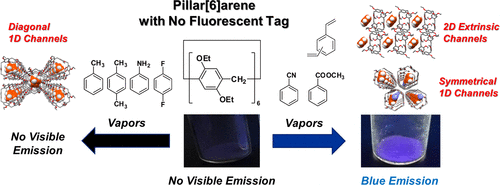当前位置:
X-MOL 学术
›
Cryst. Growth Des.
›
论文详情
Our official English website, www.x-mol.net, welcomes your feedback! (Note: you will need to create a separate account there.)
Vapoluminescence Behavior Triggered by Crystal-State Complexation between Host Crystals and Guest Vapors Exhibiting No Visible Fluorescence
Crystal Growth & Design ( IF 3.8 ) Pub Date : 2020-09-03 , DOI: 10.1021/acs.cgd.0c00982 Tomoki Ogoshi 1 , Yukie Hamada , Ryuta Sueto , Ryosuke Kojima , Fumiyasu Sakakibara , Yuuya Nagata 1 , Yoko Sakata , Shigehisa Akine , Toshikazu Ono 2 , Takahiro Kakuta , Tada-aki Yamagishi
Crystal Growth & Design ( IF 3.8 ) Pub Date : 2020-09-03 , DOI: 10.1021/acs.cgd.0c00982 Tomoki Ogoshi 1 , Yukie Hamada , Ryuta Sueto , Ryosuke Kojima , Fumiyasu Sakakibara , Yuuya Nagata 1 , Yoko Sakata , Shigehisa Akine , Toshikazu Ono 2 , Takahiro Kakuta , Tada-aki Yamagishi
Affiliation

|
A rational design to create vapoluminescence materials is to install fluorescent tags into molecules. Changing the distance and arrangement of the fluorescent tags can be performed to trigger the vapoluminescence behavior. Herein, we unexpectedly observed a vapoluminescence behavior triggered by a crystal-state host–guest complexation between pillar[6]arene host crystals and organic guest vapors that both exhibit no fluorescence in the visible-light region. After the uptake of the guest vapors, the host–guest complex crystals exhibit blue fluorescence in the visible-light region. Charge-transfer interactions between the host and guest molecules in the crystal state mainly contribute to the observation of fluorescence in the visible-light region.
中文翻译:

主体晶体和没有可见荧光的客体蒸气之间的晶态络合触发的蒸气发光行为
产生电子发光材料的合理设计是将荧光标签安装到分子中。可以执行荧光标签的距离和排列的改变以触发电子发光行为。在这里,我们出乎意料地观察到柱[6]芳烃主体晶体与有机客体蒸气在可见光区域均不显示荧光的晶态主体-客体络合物引发的气相发光行为。吸收客体蒸气后,主体-客体复合晶体在可见光区域显示蓝色荧光。晶体状态下的主体与客体分子之间的电荷转移相互作用主要有助于观察可见光区域的荧光。
更新日期:2020-11-04
中文翻译:

主体晶体和没有可见荧光的客体蒸气之间的晶态络合触发的蒸气发光行为
产生电子发光材料的合理设计是将荧光标签安装到分子中。可以执行荧光标签的距离和排列的改变以触发电子发光行为。在这里,我们出乎意料地观察到柱[6]芳烃主体晶体与有机客体蒸气在可见光区域均不显示荧光的晶态主体-客体络合物引发的气相发光行为。吸收客体蒸气后,主体-客体复合晶体在可见光区域显示蓝色荧光。晶体状态下的主体与客体分子之间的电荷转移相互作用主要有助于观察可见光区域的荧光。



























 京公网安备 11010802027423号
京公网安备 11010802027423号